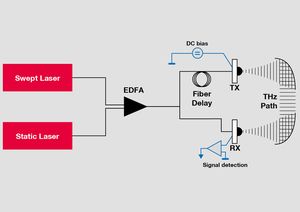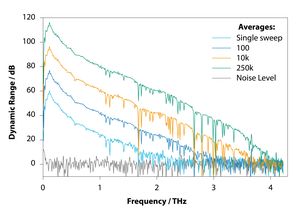 System schematic. The outputs of a rapidly swept laser and a static laser are combined in a fiber-optic array and amplified in an Erbium fiber amplifier (EDFA). One of the paths features a fiber delay. Transmitter and receiver use InGaAs photomixer technology.
System schematic. The outputs of a rapidly swept laser and a static laser are combined in a fiber-optic array and amplified in an Erbium fiber amplifier (EDFA). One of the paths features a fiber delay. Transmitter and receiver use InGaAs photomixer technology.
Fast Optoelectronic FMCW Unit
70 traces per second with 2 THz bandwidth
- Measurement rate up to 500 Hz
- Up to 4 THz bandwidth
- Robust design, no moving parts
- Multi-channel scalability
- New: 8-Channel Technology Demonstrator “T-Sweeper x8”
Rapidly swept lasers offer an alternative to established distributed feedback diodes for applications in which measurement speed is more relevant than frequency resolution. One implementation combines a fast, widely tunable laser and a static source into a “frequency-modulated continuous-wave” (FMCW) terahertz system. Equipped with state-of-the-art photomixers, the system acquires spectra with more than 2 THz bandwidth in less than 15 ms. Akin to pulsed systems, trace averaging reduces the noise floor and consequently, broadens the useable frequency range: With 2 minutes of averaging, the bandwidth increases to more than 3.5 THz. Users can conveniently set the number of averages in the control software, and therefore optimize system performance with respect to either measurement speed, or dynamic range and bandwidth.
An important difference to pulsed systems: The fast FMCW unit utilizes an InGaAs-based p-i-n photodiode as terahertz emitter, and consequently, the spectrum peaks at approximately 0.1 THz – significantly lower than the 1.0 THz peak of pulsed spectra. Owing to the lower peak frequency, the signals generated by the fast FMCW unit have a higher penetration depth in many polymers, a property that makes the system particularly attractive for thickness measurements on thick samples.
A key feature of the FMCW implementation is its scalability with respect to the number of measurement channels. This has been successfully demonstrated by Fraunhofer HHI and Fraunhofer ITWM in collaboration with TOPTICA: the consortium built the “T-Sweeper x8” prototype, the world‘s first optoelectronic 8-channel FMCW THz system. Each of the eight channels can measure and process up to 500 thickness values per second. Possible applications include multi-channel layer thickness measurements, e.g. on large structures, but also more advanced experimental concepts like synthetic aperture radar.



